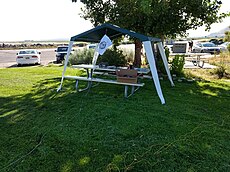Parks On The Air (POTA)
Parks On The Air (POTA) is an amateur radio operating award program. POTA is a non-profit organization, and was inspired by the work of Sean Kutzko and Norm Fusaro from the American Radio Relay League (ARRL) in 2016. POTA’s aim is to encourage licensed amateur radio operators to operate temporarily from, and bring more visibility, awareness and appreciation to not just national and state/province level parks.[1][2], but also National Monuments, National Preserves, Wildlife Refuges, Wetland Management Districts, National Wild and Scenic Rivers Systems, Wildlife Management Areas, Antarctic Stations, National Military Parks, Historical Trails, and Amateur Radio.

Those who set up a station at a park (usually for a few minutes to a few hours) are known as activators, and those who contact ("work") activators on parks are known as hunters.
Points are awarded to the activator for operating from ("activating") a park, and to each of the hunters contacting ("working") the activator. The rules[3] include that "You and all the equipment you use need to be within the perimeters of the park, and on federal or state/provincial owned land." This encourages ham operators to get out of the house and operate. POTA is a hobby, that at the same time, maintains our disaster preparedness by practicing, while having fun. POTA also increases exposure to the public, to further interest in amateur radio, thus adding newer participants to the hobby.
A dedicated website, potawatch, shows real time information about the ongoing and planned pota activations ("spots" and "alerts").

List of registered Parks[edit]
In the United States[edit]
As of May 2019, over 5,760 Parks have been registered. Of those 5,760 Parks, there have been 511053 contacts, activated by over 490 activators, and hunted by over 1,500 hunters.[3]
The official list of POTA Parks is published on "the pota park list", and their location can be displayed on maps on https://parksontheair.com/#map-list.
Internationally[edit]
The list of POTA parks outside of the US can be displayed on https://stats.parksontheair.com/reports/park-info-select.php?entity=.
Activation Locations[edit]
- Antarctic Stations
- Conservation Parks such as Cape Pallarenda Conservation Park
- Country Park such as Hainault Forest
- Historical Trails
- National Military Parks
- National Monuments
- National Nature Reserve such as Barnack Hills & Holes National Nature Reserve
- National Park such as Clump Mountain National Park or Braulio Carrillo National Park
- National Preserves
- National Wildlife Area such as Alaksen National Wildlife Area
- National Wild and Scenic Rivers Systems
- Nature Reserve such as Clackline Nature Reserve
- Provincial Parks
- Regional park such as Duder Regional Park
- Wetland Management Districts
- Wildlife Management Areas
- Wildlife Refuges
All the specific examples listed above are areas designated in the POTA database where Amateur Operators can travel to and activate. The countries currently setup in the program so far are Australia, Canada, Costa Rica, England, France, Indonesia, Italy, Malaysia, New Zealand, and the United States.
Supplementary information[edit]
The programme is very popular, with many activations of parks/areas per year. Some websites provide information about this activity[4]

Notable Activators and Hunters[edit]
One of the most notable activators is Robert Voss,[6] who as of May, 2019 has over 900 activations and over 70,000 contacts. One of the most notable hunters is William Lewis,[7] who as of May, 2019 has contacted over 2000 unique parks and over 4,700 contacts.
Other Amateur Radio Park Activities[edit]
Other related activities which occur in parks is Field Day where amateur radio operators usually go out (in the field) of operations and practice operating their ham equipment from other locations. Many operators and local clubs gather to participate in this event[8][9].
Park areas are also a good location for amateur radio clubs to organize emergency preparedness activities. Clubs which participate in ARES groups put together scenarios where a emergency situation is simulated and they will go through the steps to setup and activate a remote control operations location from a park.
Mapping of areas[edit]
As well as managing the POTA list of parks online, the website also uses the features within Google maps to reference locations within the United States[10]
Modes of Operating[edit]
An amateur radio operator is able to use any/all methods of communication between other amateur radio operators that they are currently licensed for. This includes phone (voice - most commonly used is SSB), CW (morse code), and the vast array of digital modes (such as RTTY, PSK31, FT8, etc).
See also[edit]
- DX Century Club
- VHF/UHF Century Club
- Worked All Continents
- Worked All States
- Worked All Zones
- Summits on the Air
- Islands on the Air
References[edit]
- ↑ "Parks on the Air purpose and definition".
- ↑ Dylan Vidovich (June 12, 2019). "Amateur radio clubs attempt contact at Chief Logan State Park". The Logan Banner. The Logan Banner. Retrieved June 13, 2019.
- ↑ 3.0 3.1 "General Rules".
- ↑ Jamey AC1DC (April 6, 2019). "Activation of Miller State Park/Mount Pack Monadnock K-2662". n1fd.org. Retrieved June 13, 2019.
- ↑ "KZ7ZUL Callsign Page". QRZ Callsign Database.
- ↑ "N4CD Callsign Page". QRZ Callsign Database.
- ↑ "W8ZST Callsign Page". QRZ Callsign Database.
- ↑ "Utah Amateur Radio Club Field Day Announcement". UARC Event Announcements.
- ↑ "ARRL Field Day Information". ARRL Field Day.
- ↑ "POTA Google mapping website".
| This article related to amateur radio is a stub. You can help EverybodyWiki by expanding it. |
External links[edit]
| Wikimedia Commons has media related to pota. |
- Official site
- latest spots and upcoming activations
- Links to pota related software
- pota Flickr Photo Pool
- Introductory info
- North America pota Discussion Group
Parks On The Air (POTA) new article[edit]
This article "Parks On The Air (POTA)" is from Wikipedia. The list of its authors can be seen in its historical and/or the page Edithistory:Parks On The Air (POTA). Articles copied from Draft Namespace on Wikipedia could be seen on the Draft Namespace of Wikipedia and not main one.
